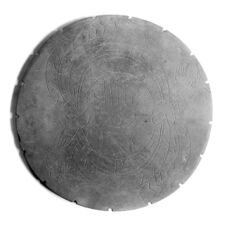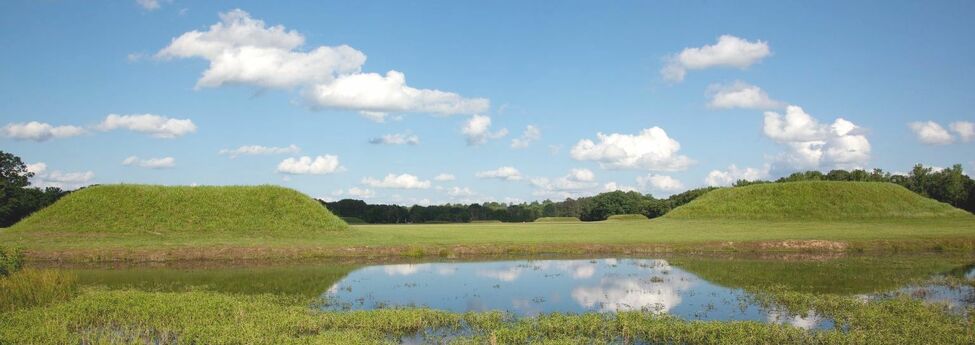Moundville Archaeological Park

Moundville Archaeological Park, formerly Mound State Monument, is 326-acre prehistoric settlement site with 29 large earthen mounds which were constructed between 1000 and 1450 by Native Americans of the Mississippian culture on a plateau overlooking the Black Warrior River in northern Hale County. The site is managed by University of Alabama Office of Archaeological Research and, along with the on-site Jones Archaeological Museum, is open to the public as part of the University of Alabama's Museum .
The Mississippian settlement at Moundville was first occupied in about 1000 AD and grew into a metropolis of regional importance beginning in about 1150. A wooden palisade was completed around the primary site by 1200, after which the population inside the enclosure may have topped 1,000 inhabitants, with nearly 10,000 living in the surrounding countryside. Through the 14th century, it is presumed to have been the most populous city of what is now Alabama. The overall arrangement of mounds around an open plaza is believed to have reflected a social system based on rival clans. The larger mounds supported lodgings for important households, with others serving various ceremonial functions.
After 1350 the Moundville site was depopulated, but remained an important ceremonial center for a century or so. By the time Hernando De Soto's band of Spanish explorers crossed the area in 1540 the Mississippian culture was all but forgotten and the Moundville site was uninhabited.
Alabama State Geologist Walter Jones headed a campaign to preserve the Moundville site as a state park. He mortgaged his own home to purchase the property in 1929. The first museum to display artifacts was dedicated at the site on May 16, 1939.
The site was declared a National Historic Landmark in 1964 and was added to the National Register of Historic Places in 1966. The museum and visitors center was expanded and remodeled in 2010.
In 1980 264 prehistoric vessels were stolen from the Archaeological Repository at Moundville. After decades of fruitless investigation, a $20,000 reward was offered for information about any missing artifacts in 2018. Three notable vessels that had been among those stolen were recovered a month later.
Archaeological investigations
Little mention of the site was made until after the Civil War when University of Alabama president Nathaniel Lupton published a map and description of the mounds. Philadelphia antiquities collector Clarence B. Moore arrived at Moundville on his own steamboat, The Gopher of Philadelphia, in the early 1900s and excavated numerous artifacts which he took home with him. His work widely publicized the site and contributed to elaboration of the "Southeastern Ceremonial Complex" which relates iconography found on artifacts at numerous prehistoric sites. Recognition of the loss of valuable materials led Alabama to pass its first law protecting archaeological sites from looting in 1915.
In the early 1930s, after purchasing the site on behalf of the University, Walter Jones worked with Alabama Museum of Natural History curator David DeJarnette to conduct the first organized scientific excavation of the mounds, under the heading of the Black Warrior River Basin Survey.
From 1933 to 1941 a group of laborers under the auspices of the Civilian Conservation Corps assisted with excavation work and also cleared the plaza, shored up eroded mounds, constructed new roads, and built a small museum to display artifacts.
The University of Alabama Department of Anthropology's Cailup Curren Jr led field excavations of several protohistoric sites between the 1930s and 1980s. Another nearby site on Big Sandy Creek was documented by Steve Wimberly in 1948.
Many of the artifacts found were studied and described by students working under Indiana University professor Christopher Peebles in the 1960s and 1970s. A group from the University of Michigan participated in field surveys at Moundville beginning in 1979.
Vernon Knight Jr led the excavation of several more mounds in the 1990s. Jim Knight has been leading additional studies to develop an ethnohistorical reconstruction of the site. Professional archeologists from Panamerican Consultants participated in some of those surveys.
Repatriations
In 2018 and 2021 representatives from the Choctaw Nation of Oklahoma, the Chickasaw Nation, the Coushatta Tribe of Louisiana, the Muscogee (Creek) Nation, the Alabama-Quassarte Tribal Town, the Seminole Nation of Oklahoma and the Seminole Tribe of Florida filed requests for thousands of objects, including 5,892 human remains and associated burial goods, to be returned to them as cultural descendants of the Moundville inhabitants under the Native American Graves Protection and Repatriation Act of 1990. RaeLynn Butler, the Muscogee Nation's historic and cultural preservation manager, characterized the University as unresponsive to the process. In November 2021 a federal review committee determined that the artifacts were culturally related to the tribes and required the University to begin inventorying and consultation.
In that inventory, published in the Federal Register on August 30, 2022, the University reported that it possessed the physical remains of 10,245 individuals of Native American ancestry, and 1,520 objects interred with those individuals.
See also
- Erskine Ramsay Archaeological Repository
- "The Road to Calvary" pageant
- "A Genesis Found" film
References
- Moore, Clarence B. (1905) Certain Aboriginal Remains of the Black Warrior River Philadelphia: Academy of Natural Sciences. Reprinted in The Moundville Expeditions of Clarence Bloomfield Moore (1996). Tuscaloosa: University of Alabama Press. ISBN 9780817308407
- Moore, Clarence B. (1907) Moundville Revisited. Philadelphia: Academy of Natural Sciences. Reprinted in The Moundville Expeditions of Clarence Bloomfield Moore (1996). Tuscaloosa: University of Alabama Press. ISBN 9780817308407
- Steponaitis, Vincas P. (1983) Ceramics, Chronology, and Community Patterns: An Archaeological Study at Moundville. New York: Academic Press. Republished 2009 by University of Alabama Press ISBN 9780817355760
- Welch, Paul D. (1991) Moundville's Economy. Tuscaloosa: University of Alabama Press. ISBN 9780817305123
- Walthall, John A. (1994) Moundville: An Introduction to the Archaeology of a Mississippian Chiefdom. Alabama Museum of Natural History. Special Publication No. 1
- Reilly, Sean (December 22, 2002) "Moundville: A breathtaking archaeological find in Alabama." Mobile Register
- Wilson, Gregory D. (2007) The Archaeology of Everyday Life at Early Moundville. Tuscaloosa: University of Alabama Press. ISBN 9780817315795
- Knight, Vernon James Jr & Vincas Steponaitis, eds. (2007) Archaeology of the Moundville Chiefdom. Tuscaloosa: University of Alabama Press. ISBN 9780817354213
- Knight, Vernon James Jr (November 30, 2009) "Discovery and Excavation of the Moundville Earth Lodge." Bulletin of the Alabama Museum of Natural History. No. 27, pp. 20-28
- Knight, Vernon James Jr (2010) Mound Excavations at Moundville: Architecture, Elites and Social Order. Tuscaloosa: University of Alabama Press. ISBN 9780817316877
- Blitz, John H. (August 18, 2017) "Moundville Archaeological Park" Encyclopedia of Alabama - accessed November 13, 2018
- Beahm, Anna (November 12, 2018) "3 of the hundreds of stolen artifacts from Moundville recovered." The Birmingham News
- Yurkanin, Amy (October 11, 2021) "Tribes ask University of Alabama to return artifacts from Moundville." The Birmingham News
- Yurkanin, Amy (November 18, 2021) "‘Give us our people back’: Muscogee push University of Alabama to return Moundville remains." The Birmingham News
- Herrera, Allison (November 29, 2021) "Federal committee says University of Alabama must return historic objects to tribes" KOSU.org
- Kunze, Jenna (December 23, 2021) "Alabama Responds to Tribal Claims; Repatriation Tentatively Moves Forward" Native News Online
- "Notice of Inventory Completion: University of Alabama Museums, Tuscaloosa, AL" (August 30, 2022) National Park Service, Document 87 FR 52995, Document Number 2022-18741
- Kunze, Jenna (September 7, 2022) "10,245 Indigenous Remains Reported at University of Alabama" Native News Online
External links
- Moundville Archaeological Park at ua.edu
- "Moundville" (1996), Episode 14 of Discovering Alabama.
